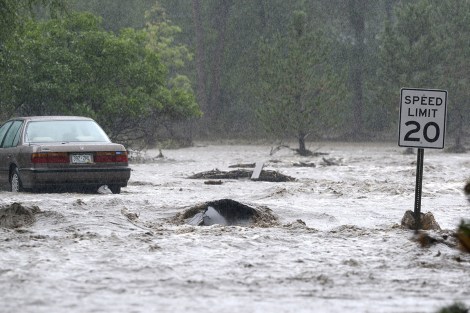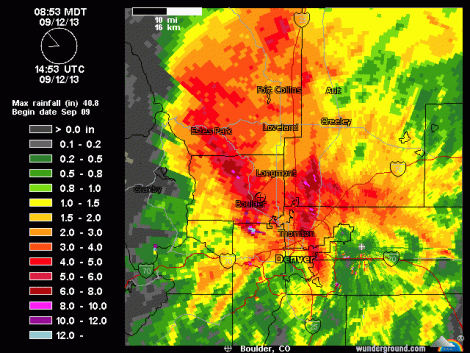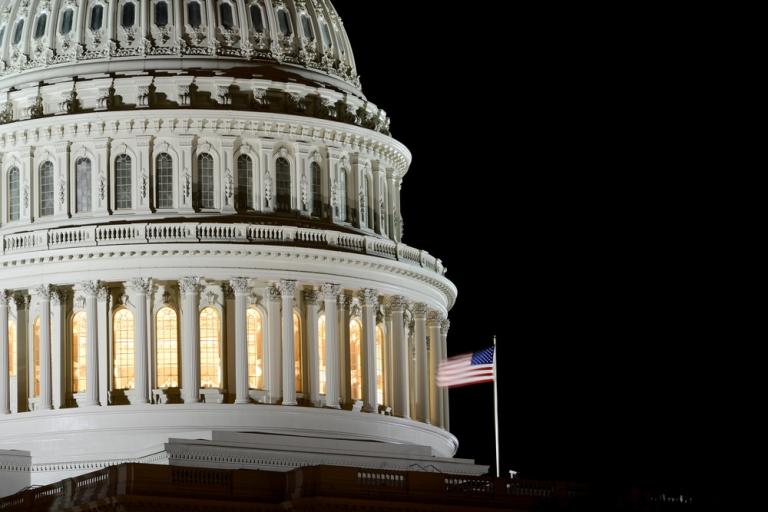
Reuters/Mark LeffingwellWater runs freely down Topaz Drive in Boulder, Colo., as heavy rains cause severe flooding on Sept. 12, 2013.
Biblical hell has broken out in Colorado, where more than six inches of rain fell in 24 hours, contributing to flash floods that killed at least three people.
(Before you complain about our use of “biblical,” note that it’s the word federal forecasters chose to describe the flooding in an official update on the National Weather Service website.)
“It’s insane right now, I’ve lived in Colorado my whole life, and this is nothing that I’ve ever, ever seen before,” Andra Coberly, spokesperson for the YMCA in Boulder, where soggy residents were taking shelter, told NBC. “Streets were turned into rivers and streams were turned into lakes.” From the NBC report:
The torrential downpours that lashed parts of Colorado drove hundreds of people from their homes, shut down Boulder and the nearby university, and had police and fire responders scrambling all day as they worked to help stranded residents in what they described as a still-developing disaster.
The bad weather also hampered rescue efforts, making it impossible to get search and rescue helicopters into the air, officials said at a press conference on Thursday afternoon, and increasing the dangers for responders who tried to make their way into some of the most affected areas. About 6.8 inches of rain fell over the city in a 24-hour period, according to the National Weather Service.
Slate science correspondent Phil Plait reported from Boulder that the sheriff was asking people to stay inside and off the roads. His post describes the years of climatic pandemonium that culminated with this week’s deluge:
We’ve been suffering a long drought in my hometown of Boulder, Colo., including unusually hot weather for the past few summers. The ground has been pretty hard, and we’ve had fires, which reduce the vegetation. It’s been worrisome for some time, because we knew if it rained hard, we could be in trouble.
We’re in trouble.
It started raining off and on a month or more ago, but then a couple of days ago, the skies opened up. We’ve had more than an inch of rain in some places, and it’s had nowhere to go but down from the foothills of the Rockies. Boulder is now flooding; the Boulder Creek crested at 2.7 meters (8.8 feet) last night, well above its usual height.
Further afield, folks at the Cooperative Institute for Meteorological Satellite Studies at the University of Wisconsin-Madison have been poring over satellite images and other data to try to make sense of the waterlogged chaos. Their startling conclusion: “This event could be classified as a 500- to 1000-year event.”
Meteorologist Jeff Masters explained in his Weather Underground blog that “a flow of extremely moist air” from the southeast pushed up against the mountains, expanding and cooling as it climbed, “forcing the moisture in it to fall as rain.” He posted the following map, showing that rainfall on Wednesday and Thursday was not only heavy around Boulder — the inundation was regional:

wunderground.comRadar-estimated rainfall of six to eight inches on Wednesday and Thursday shown in dark red. (Click to embiggen.)
The Boulder area may not need to wait 1,000 years for another storm like this. Coloradans have been enduring wild swings in the weather in just the last few years — parched by drought, ravaged by fire, blanketed by unseasonable snow, and now swamped with floods — near-textbook examples of the climatic extremes that global warming is expected to wreak on the world.




